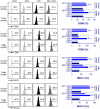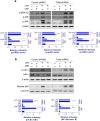Chrysin Derivative CM1 and Exhibited Anti-Inflammatory Action by Upregulating Toll-Interacting Protein Expression in Lipopolysaccharide-Stimulated RAW264.7 Macrophage Cells
- PMID: 33799689
- PMCID: PMC8000858
- DOI: 10.3390/molecules26061532
Chrysin Derivative CM1 and Exhibited Anti-Inflammatory Action by Upregulating Toll-Interacting Protein Expression in Lipopolysaccharide-Stimulated RAW264.7 Macrophage Cells
Abstract
Although our previous study revealed that gamma-irradiated chrysin enhanced anti-inflammatory activity compared to intact chrysin, it remains unclear whether the chrysin derivative, CM1, produced by gamma irradiation, negatively regulates toll-like receptor (TLR) signaling. In this study, we investigated the molecular basis for the downregulation of TLR4 signal transduction by CM1 in macrophages. We initially determined the appropriate concentration of CM1 and found no cellular toxicity below 2 μg/mL. Upon stimulation with lipopolysaccharide (LPS), CM1 modulated LPS-stimulated inflammatory action by suppressing the release of proinflammatory mediators (cytokines TNF-α and IL-6) and nitric oxide (NO) and downregulated the mitogen-activated protein kinase (MAPK) and nuclear factor-κB (NF-κB) signaling pathways. Furthermore, CM1 markedly elevated the expression of the TLR negative regulator toll-interacting protein (Tollip) in dose- and time-dependent manners. LPS-induced expression of cell surface molecules (CD80, CD86, and MHC class I/II), proinflammatory cytokines (TNF-α and IL-6), COX-2, and iNOS-mediated NO were inhibited by CM1; these effects were prevented by the knockdown of Tollip expression. Additionally, CM1 did not affect the downregulation of LPS-induced expression of MAPKs and NF-κB signaling in Tollip-downregulated cells. These findings provide insight into effective therapeutic intervention of inflammatory disease by increasing the understanding of the negative regulation of TLR signaling induced by CM1.
Keywords: anti-inflammatory activity; chrysin derivative; macrophage; toll-interacting protein; toll-like receptor negative regulator.
Conflict of interest statement
The authors declare no conflict of interests.
Figures





Similar articles
-
RM, a novel resveratrol derivative, attenuates inflammatory responses induced by lipopolysaccharide via selectively increasing the Tollip protein in macrophages: A partial mechanism with therapeutic potential in an inflammatory setting.Int Immunopharmacol. 2020 Jan;78:106072. doi: 10.1016/j.intimp.2019.106072. Epub 2019 Dec 10. Int Immunopharmacol. 2020. PMID: 31835082
-
Isotrifoliol inhibits pro-inflammatory mediators by suppression of TLR/NF-κB and TLR/MAPK signaling in LPS-induced RAW264.7 cells.Int Immunopharmacol. 2017 Apr;45:110-119. doi: 10.1016/j.intimp.2017.01.033. Epub 2017 Feb 10. Int Immunopharmacol. 2017. PMID: 28192731
-
Sparassis crispa exerts anti-inflammatory activity via suppression of TLR-mediated NF-κB and MAPK signaling pathways in LPS-induced RAW264.7 macrophage cells.J Ethnopharmacol. 2019 Mar 1;231:10-18. doi: 10.1016/j.jep.2018.11.003. Epub 2018 Nov 3. J Ethnopharmacol. 2019. PMID: 30395976
-
Flavonoid diversity and roles in the lipopolysaccharide-mediated inflammatory response of monocytes and macrophages.Future Med Chem. 2024 Jan;16(1):75-99. doi: 10.4155/fmc-2023-0174. Epub 2024 Jan 11. Future Med Chem. 2024. PMID: 38205612 Review.
-
Comprehensive and critical view on the anti-inflammatory and immunomodulatory role of natural phenolic antioxidants.Eur J Med Chem. 2024 Feb 5;265:116075. doi: 10.1016/j.ejmech.2023.116075. Epub 2023 Dec 21. Eur J Med Chem. 2024. PMID: 38150963 Review.
Cited by
-
Exploring the Anti-inflammatory Potential of Novel Chrysin Derivatives through Cyclooxygenase-2 Inhibition.ACS Omega. 2024 Dec 10;9(51):50491-50503. doi: 10.1021/acsomega.4c07938. eCollection 2024 Dec 24. ACS Omega. 2024. PMID: 39741845 Free PMC article.
-
Synthesis and Bioevaluation of New Stable Derivatives of Chrysin-8-C-Glucoside That Modulate the Antioxidant Keap1/Nrf2/HO-1 Pathway in Human Macrophages.Pharmaceuticals (Basel). 2024 Oct 17;17(10):1388. doi: 10.3390/ph17101388. Pharmaceuticals (Basel). 2024. PMID: 39459027 Free PMC article.
-
Pinelliae rhizoma alleviated acute lung injury induced by lipopolysaccharide via suppressing endoplasmic reticulum stress-mediated NLRP3 inflammasome.Front Pharmacol. 2022 Aug 15;13:883865. doi: 10.3389/fphar.2022.883865. eCollection 2022. Front Pharmacol. 2022. PMID: 36046826 Free PMC article.
-
Advancements and recent explorations of anti-cancer activity of chrysin: from molecular targets to therapeutic perspective.Explor Target Antitumor Ther. 2024;5(3):477-494. doi: 10.37349/etat.2024.00230. Epub 2024 May 23. Explor Target Antitumor Ther. 2024. PMID: 38966181 Free PMC article. Review.
-
CM1, a Chrysin Derivative, Protects from Endotoxin-Induced Lethal Shock by Regulating the Excessive Activation of Inflammatory Responses.Nutrients. 2024 Feb 25;16(5):641. doi: 10.3390/nu16050641. Nutrients. 2024. PMID: 38474770 Free PMC article.
References
MeSH terms
Substances
Grants and funding
LinkOut - more resources
Full Text Sources
Other Literature Sources
Research Materials

